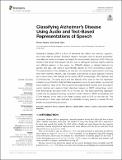Classifying Alzheimer's Disease Using Audio and Text-Based Representations of Speech
Author(s)
Haulcy, R'mani(R'mani Symon); Glass, James R
Downloadfpsyg-11-624137.pdf (621.1Kb)
Publisher with Creative Commons License
Publisher with Creative Commons License
Creative Commons Attribution
Terms of use
Metadata
Show full item recordAbstract
Alzheimer's Disease (AD) is a form of dementia that affects the memory, cognition, and motor skills of patients. Extensive research has been done to develop accessible, cost-effective, and non-invasive techniques for the automatic detection of AD. Previous research has shown that speech can be used to distinguish between healthy patients and afflicted patients. In this paper, the ADReSS dataset, a dataset balanced by gender and age, was used to automatically classify AD from spontaneous speech. The performance of five classifiers, as well as a convolutional neural network and long short-term memory network, was compared when trained on audio features (i-vectors and x-vectors) and text features (word vectors, BERT embeddings, LIWC features, and CLAN features). The same audio and text features were used to train five regression models to predict the Mini-Mental State Examination score for each patient, a score that has a maximum value of 30. The top-performing classification models were the support vector machine and random forest classifiers trained on BERT embeddings, which both achieved an accuracy of 85.4% on the test set. The best-performing regression model was the gradient boosting regression model trained on BERT embeddings and CLAN features, which had a root mean squared error of 4.56 on the test set. The performance on both tasks illustrates the feasibility of using speech to classify AD and predict neuropsychological scores.
Date issued
2021-01Department
Massachusetts Institute of Technology. Computer Science and Artificial Intelligence LaboratoryJournal
Frontiers in Psyhcology
Publisher
Frontiers Media SA
Citation
Haulcy, R'mani and James Glass. "Classifying Alzheimer's Disease Using Audio and Text-Based Representations of Speech." Frontiers in Psyhcology 11 (January 2021): 624137. © 2021 Haulcy and Glass
Version: Final published version
ISSN
1664-1078